 W
WA military armored car is a lightweight wheeled armored fighting vehicle, historically employed for reconnaissance, internal security, armed escort, and other subordinate battlefield tasks. With the gradual decline of mounted cavalry, armored cars were developed for carrying out duties formerly assigned to light cavalry. Following the invention of the tank, the armored car remained popular due to its faster speed, comparatively simplified maintenance and low production cost. It also found favor with several colonial armies as a cheaper weapon for use in underdeveloped regions. During World War II, most armored cars were engineered for reconnaissance and passive observation, while others were devoted to communications tasks. Some equipped with heavier armament could even substitute for tracked combat vehicles in favorable conditions—such as pursuit or flanking maneuvers during the North African Campaign.
 W
WThe Bravia Chaimite is an armored vehicle with all wheel drive axles built by the Portuguese company Bravia and used by the Portuguese Army in the Portuguese colonial wars in Angola, Mozambique and Portuguese Guinea, from 1967 to 1974 when it ended. The Chaimite was originally an unlicensed derivative of the Cadillac Gage Commando assembled and later produced in Portugal, with a number of improvements and technical modifications.
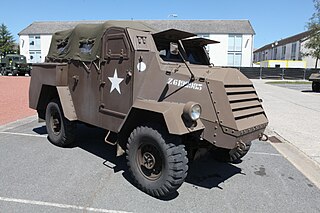 W
WThe C15TA Armoured Truck was an armoured load carrier produced by Canada during the Second World War. It was developed from the Otter Light Reconnaissance Car.
 W
WThe Daimler Scout Car, known in service as the Daimler Dingo, was a British light, fast four-wheel drive reconnaissance vehicle also used for liaison during the Second World War.
 W
WThe Eland is an air portable light armoured car based on the Panhard AML. Designed and built for long-range reconnaissance, it mounts either a 60mm (2.4 in) breech-loading mortar or a Denel 90mm (3.5 in) gun on a very compact chassis. Although lightly armoured, the vehicle's permanent 4X4 drive makes it faster over flat terrain than many tanks.
 W
WThe Hippo is a South African armoured personnel carrier. Specially designed to be mine resistant, it can carry ten infantrymen and a crew of two. The vehicle's remote-operated turret mounts dual 7.62mm machine guns, but like other improvised fighting vehicles, it is only lightly protected against ballistic threats.
 W
WThe Komatsu light armored vehicle (Japanese: 軽装甲機動車; is a Japanese military vehicle first produced in 2002. Currently used exclusively by the Japan Self-Defense Force, it has seen use in the Iraq War. It is built by Komatsu Ltd. Defense Systems Division in Komatsu, Ishikawa, Japan. Komatsu's factory designator for the vehicle is KU50W.
 W
WThe Land Rover Tangi is a type of armoured vehicle, based on the Land Rover chassis and used in policing in Northern Ireland. They were used by the Royal Ulster Constabulary (RUC) and are currently used by their replacement, the Police Service of Northern Ireland (PSNI). The vehicle was designed and built in house by the Royal Ulster Constabulary's own engineers.
 W
WThe M1117 Guardian, also denoted Armored Security Vehicle (ASV), is an internal security vehicle based on the V-100 and V-150 Commando series of armored cars. It was developed in the late 1990s for service with the United States Military Police Corps. The first prototypes appeared in February 1997 and serial production of the M1117 commenced between 1999 and early 2000.
 W
WThe Maverick is an internal security vehicle that was designed and developed by the Paramount Group in South Africa.
 W
WThe MOWAG MR8-01 (Wotan) is an armored personnel carriers.
 W
WThe Cobra is a family of armored vehicles produced by Otokar of Turkey. It is produced in two generations.
 W
WThe Panhard AML is a fast, long-ranged, and relatively cheap armoured car with excellent reconnaissance capability. Designed on a small, lightly armoured 4×4 chassis, it weighs an estimated 5.5 tonnes, and thus suitable for airborne deployment. Since 1959 AMLs have been marketed on up to five continents; several variants remained in continuous production for half a century. These have been operated by fifty-four national governments and other entities worldwide, seeing regular combat.
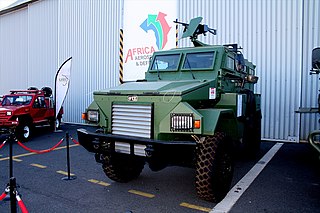 W
WThe Puma M26-15 4x4 is an armored personnel carrier (APC) with mine and improvised explosive device (IED) protection. The main users are military, police and security companies during peacekeeping operations. The Puma M26 was designed by OTT Technologies, a South African firm linked to DynCorp International. It is manufactured in South Africa and Mozambique.
 W
WPrototype Designed by TFM Industries by a developer Steve van Rooyen. From a model scaled. The RG-12 is a multi-purpose armoured personnel carrier with anti-personnel mine, grenade, fire bomb and small arms fire protection that is manufactured by Land Systems OMC of South Africa, with over 700 being in service globally in more than eight countries.
 W
WThe RG-34 is a South African Mine-Resistant Ambush Protected vehicle (MRAP). Specially designed to be mine-resistant, it has been produced in multiple variants, equipped for troop or cargo transport, command, and fire support. Originally showcased with a wide turret ring and a 90mm rifled cannon, the RG-34 was one of the first MRAPs configured to carry a large gun system.
 W
WThe Saxon is an armoured personnel carrier used by the British Army and supplied in small numbers to various overseas organisations. It was developed by GKN Sankey from earlier projects, AT 100 IS and AT104, and was due to be replaced by the Future Rapid Effect System. It was first produced by Alvis plc.
 W
WThe Shorland is an armoured patrol car that was designed specifically for the Royal Ulster Constabulary by Frederick Butler. The first design meeting took place in November 1961. The third and final prototype was completed in 1964 and the first RUC Shorlands were delivered in 1966. They were reallocated to the Ulster Defence Regiment in 1970. The Royal Ulster Constabulary soon replaced the Shorland with an armoured Land Rover with more conventional profile and no machine gun turret.
 W
WThe Sonder Kfz-1 and SK-1, also known as Garant 30k SK-1, was an East German armored patrol vehicle introduced by the East German Police in 1953. It was used by the Kasernierte Volkspolizei and for a short time by the National People's Army. The SK-1 is the chassis of a Robur Garant 30K truck fitted with an armored body and a light turret. There is a door in the rear of the hull for the crew to enter, and a hatch on top of the turret. The turret has several vision slits and a hole for a machinegun. With the reunification of Germany, most of the SK-1s were scrapped, except for some sent to museums or private collectors.
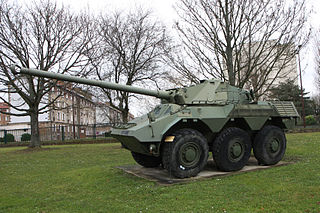 W
WThe Renault VBC-90 is a six-wheeled French armoured car carrying a 90mm high-velocity gun mated to a sophisticated fire control computer and ranging system. It was developed primarily for internal security or armed reconnaissance purposes. Modeled after Renault's Véhicule de l'Avant Blindé (VAB) armoured personnel carrier, the VBC-90 was engineered in concert with Saviem and Creusot-Loire. One was also built in prototype form by Argentina under license, where it was known as the Vehículos de Apoyo y Exploración. VBC-90s were available with various chassis configurations resembling both the VAB and the Berliet VXB-170.
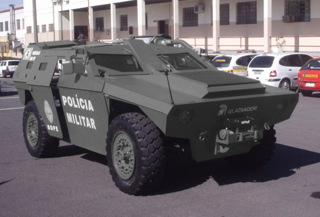 W
WThe Light Armored Vehicle (PBL) - Group project Inbrafiltro - is designed for special operations security, in which the troops need protection and great mobility.
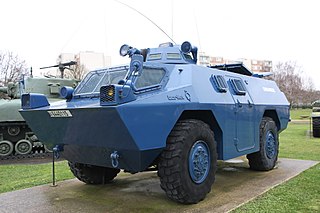 W
WThe Berliet VXB-170 is a four-wheel armoured vehicle used primarily as an internal security vehicle. Developed and initially produced by Berliet until Berliet was merged with Saviem to form Renault Trucks, it lost to the Saviem VAB the competition to equip the French Army, even though it was cheaper than its competitor. Production stopped after less than 200 vehicles had been produced.
 W
WThe Wolf Armoured Vehicle is an armoured personnel carrier, used mainly by the Israeli Defence Force. It was created to provide a better handling and better protected armoured vehicle than the M113 (Bardelas). The Wolf is a heavily armoured crew carrier, manufactured by the company Carmor. It combines a commercial truck's speed and maneuverability and APC-like armour, qualities necessary for low-intensity confrontation. The Wolf's chassis is based on a Ford F-550 truck, and is equipped with a 6-litre V8 engine capable of reaching 325 horsepower. The engine is combined with a 5-speed automatic transmission, which drives all four wheels, making this a four-by-four.
 W
WThe WZ-523 is a six-wheeled Chinese armored personnel carrier designed to be amphibious. Built on the chassis of the Hanyang HY472 truck, it can carry a crew of three and seat up to eight additional passengers. Two primary models were produced—one with a roof-mounted 12.7mm heavy machine gun, and the other with a small turret armed with a 35mm grenade launcher and a 7.62mm co-axial general purpose machine gun. An export model that entered service in 2008 as a fire support vehicle was also marketed successfully to the Namibian Army; this is armed with a 73mm 2A28 Grom smoothbore cannon in exactly the same turret as used on the Soviet BMP-1 infantry fighting vehicle.